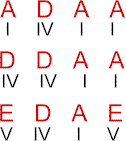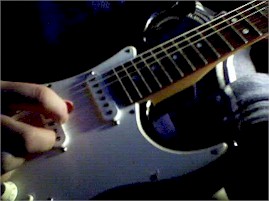Scroll through the lesson and click on notation/video/audio links to load the interactive players.
Please subscribe to get full access to all lessons for only $7.95/month PLUS 1 week free trial.

Riff Interactive lessons are
LESS expensive and
MORE interactive than alternatives!
More Info
|
|
| Lesson Subject:
Eric Clapton Style |
| What you learn:
Part 1 - Blues Scales |
| Teacher:
Storm Stenvold |
Storm: In this lesson you will learn
the foundation of the Eric Clapton style guitar, mostly built around the 12 bar
blues. Eric first came to
people's attention as the guitarist for the Yardbirds. When they moved in a more
pop direction, Eric left to join John Mayall's
Bluesbreakers. Here's a jam track you'll use in this
lesson:
12 Bar
Blues - Key of A (Shuffle)
Storm: This 12 bar progression is fundamental
to all of Eric's work of this period, and up to present
day. Here are some stock voicing for the
three chords that make up the progression. A D E. All are 'dominant'
chords.
Storm:
A cool move to use is this sliding riff, outlining extensions of these basic
chords.
Storm:
Use either a clean or a distorted tone setting. Eric used both at any
time.
bluesman:
I heard that some of his sound he got from using a blown speaker in his
amp?
Storm: In his early work Eric favored Vox
amplifiers, driving them hard by playing at loud volumes. Later
Marshalls.
Buud:
I saw an ad for a effects pedal to give a "bluesy" sound. Are they any good, or
is a real tube amp the right answer?
Storm: Can't beat tubes, I think. But the
neighbors might not agree because you usually have to play them loud to get the
right tone. Now the twelve bar blues progression
follows these three chords, A D E. We could also refer to them as one, four and
five by their position within the key.
12-Bar Progression in 'A'

Storm: The progression starts on the I chord,
'A', before making a quick change to the IV chord, 'D'. The back to A for bars
three and four. 'D' for the next two, back to 'A' for
two bars. Then finishing with 'E' for a bar, 'D'
for a bar, then 'A' and 'E'. The fundamental scale for the progression
is the 'Blues Scale'. We want to know this forwards, backwards, up and down. The
circled notes are the b5's or 'blues notes'.
Storm: This scale works over the entire
progression. Try it against the jam
track. If you eliminate the b5 notes in the
blues scale, you get the five-note 'Minor Pentatonic' scale. Add them and you
have the six-note 'Blues Scale'. The Minor Pentatonic would be another of
Eric's favorite choices. Here are some useful extension patterns,
same notes but higher up the neck:
justin: What is
an extension pattern?
Storm: Extension patterns, meaning the same
notes just in a different area of the
neck. It is good to have one pattern for each
scale that you are really familiar and comfortable with, that you can apply.
justin: So if I
play this, it is like playing the A blues from the 5th fret just different area
of the neck?
Storm: But after
that, different finger positions for the same note can reach higher or lower
notes, lend themselves to different licks, etc. Exactly, justin. You got
it.
Buud: Isn't
there also a 3 octave scale that has some slides in it? Can you give us that
pattern too?
Storm: Here's another pattern with slides. Use
just two fingers, sliding the third going up. Try going down using first finger
slides.
Storm:
This can be a great one to break out of 'boxes'. Allows you to slip and slide
your way from one to the next. And now the brother of that pentatonic
guy.
Storm:
'Major' Pentatonic. Maybe spent some time in the service. But still
'sweet.' Learn that tab 1 scale with the
fingerings suggest. It is the basis for a lot of 'position shifting'
licks. The Major Pentatonic would be a final
important pattern for Clapton's sound. Major Pentatonic, Minor Pentatonic and
Blues Scale - those are the important
three.
Storm:
Now know these three scales separately for their own sound. Minor and Blues
sound good over the entire progression. Major pentatonic sounds best when the
progression is on the I chord, same root note as the scale
root. But after knowing that, Clapton will
flow between these within the same
phrase.
Storm:
Another popular combination scale, with a namesake.
Storm:
I final set of shapes to brush up on are 'sixths'.
Storm: Sixths can be played fingerstyle or, by
muting with the left hand fingers,
strummed. Or hybrid picking, using the pick on the
heavier string and the middle finger on the lighter string. That is kind of a
slick technique to incorporate.
hybrid picking

Beestin: What are "sixths"?
Storm: Sixth refers to the distance they are
apart in the scale. An interval. The scale for these chords
is the Mixolydian, or dominant, mode. You can learn the names or just recognize
the sounds.
Storm:
Well I have to go. I will send another Jam Track. The homework is to learn this
stuff, then try to transpose it to the next Jam Track key. 'Key of
G'
Bluesbreakers
12-Bar
Storm: That's all for this lesson. Next lesson,
Clapton riffs from his Yardbirds and Bluesbreakers days.
|
<< load notation from left
|
|
<< load audio from left
|
<< load audio from left
|